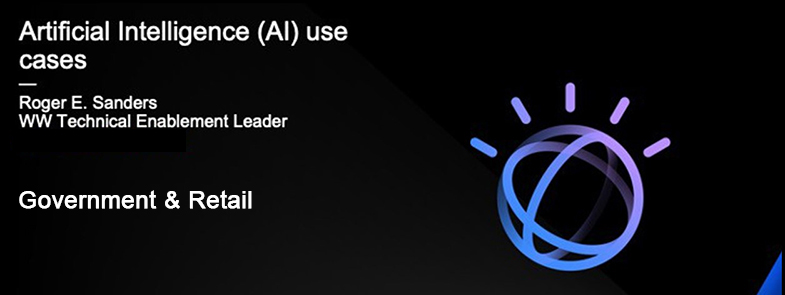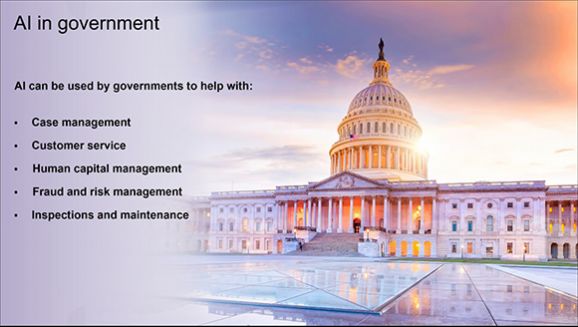Most government departments around the world are underfunded, understaffed, and face massive backlogs.
The resulting costs are both financial and reputational, since the inability to deliver core services in a timely manner directly impacts the lives of every citizen. Consequently, the potential uses for artificial intelligence (AI), machine learning (ML), and deep learning (DL) in government are wide and varied. And, according to research conducted by Accenture for their Accenture Federal Technology Vision 2018 report, federal agencies are ready and willing to employ AI in their operations.
When preparing this report, Accenture documented nearly one hundred discrete use cases across various agencies in the civilian, national security, law enforcement/public safety, and healthcare sectors. Therefore, it’s clear that AI can readily drive improvements in the following areas today:
- Case management: In government, case management refers to the organization and coordination of formal and informal activities, services, and support that is designed to optimize the well-being of a citizen. High case volumes, manual data entry, lack of integrated data, and ad-hoc decision making can result in long processing times, inaccurate reporting, and inconsistent outcomes. ML with robotic process automation (RPA) can reduce or eliminate manual, error-prone activities; automate decision making; add visibility, traceability, and compliance; and enhance case outcomes.
- Customer service: Extended call wait times and case backlogs create a poor customer experience that can result in non-compliance, loss of revenue, and poor public reputation. Virtual agents or “chatbots,” together with natural language processing (NLP), can enable customer self-service and route citizens to the right information or representatives faster.
- Human capital management: Challenges in executing targeted recruiting in a timely and effective manner, identifying potential candidates for new positions, and assessing the competencies of potential new hires can compound existing backlog issues. ML can be used in this area to help identify applicants with the skills and behaviors needed to fill positions, as well as predict future job success. For instance, the United States Army uses an interactive virtual assistant to check qualifications, answer questions, and refer potential recruits to human recruiters. It does the work of 55 recruiters at a 94% accuracy rate that is improving as the system learns.
- Fraud and risk management: Fraud poses a significant risk to the integrity of government programs and erodes the public’s trust. And siloed data and organization structures can make it difficult to identify and proactively reduce or eliminate vulnerabilities. By analyzing behaviors and identifying trends in fraud and abuse, ML models can detect anomalies and flag suspicious behavior in a timely manner.
- Inspections and maintenance: Regular inspections and maintenance keep systems running, minimizes repair costs, and ensures safety. AI, ML, and DL models can analyze data from remote sensors, surveillance videos, and other resources to predict things like potential mechanical failures, high likelihood of contaminated food, or public safety threats, saving time and enabling investigators to take preemptive action. For example, the Las Vegas Health Department used AI to mine useful insights from social media posts to help them fine-tune their selection of restaurants to inspect for health violations. The result was an increase in citations, 9,000 fewer cases of food poisoning, and over 500 less food poisoning related hospital admissions.
AI, ML, and DL can also be used to do things like:
- Reduce tax evasion by analyzing and comparing information from state and federal sources to find discrepancies.
- Identify areas where criminal activity is high and locate criminals by analyzing historical crime data and using facial recognition software to analyze thousands of hours of video footage in crime or terrorist-related events.
- Identify criminals most likely to re-offend by analyzing records of past offenders and identifying corresponding risk factors from criminological and psychological research.
- Increase foster child placement success in permanent homes by uncovering relational patterns in characteristics such as age, health, geographic location, and education level.
- Help identify the needs of citizens based on locality, poverty levels, age, race, gender, physical and mental impairment, and so forth.
- Determine how taxes are calculated and prioritize how and where funding is spent by analyzing the sentiment of citizens and providing transparency, accountability, and explainability of all AI models used.
- Identify students at risk of failing, dropping out, or changing schools.
These are just a few areas where AI, ML, and DL can be used to aid governments. The list is endless.
Sources:
Artificial intelligence in government: (Deloitte)
https://www2.deloitte.com/us/en/insights/focus/artificial-intelligence-in-government.html
Accenture Federal Technology Vision 2018: (Accenture)
https://www.accenture.com/us-en/insight-technology-trends-2018
_____________________________________________________________________________
Today’s retail industry is more fragmented and competitive than ever. Some might argue it’s shrinking as well, since more and more brick-and-mortar stores are closing their doors. In a research note published in 2021, Union Bank of Switzerland (UBS) forecast that some 80,000 US retail stores, or roughly 9% of the current total, will shut their doors for good by 2026. This forecast is based on the assumption that e-commerce as a percentage of total retail sales will jump to 27% – up from 18% now, which is already several percentage points higher than had been expected prior to the COVID-19 pandemic.
And although the internet, automation, and a shortage of workers are helping drive retail store closures, artificial intelligence (AI), machine learning (ML), and deep learning (DL) – together with an increase in online penetration – could be what helps some retailers stay in business. Areas in which AI, ML, and DL have the potential to completely transform the traditional retail model include:
- Improving customer experience: Customer experience should always be a top focus for businesses – keeping existing customers happy is easier, and yields a much better return, than having to constantly find new consumers. (In fact, as much as 80% of future profit comes from 20% of existing customers.) That’s why providing a good customer experience is a common goal among retailers. AI, ML, and DL can draw conclusions from historical data to create a far more engaging, personalized customer experience, based on interests and likes. It can also be used to make the whole shopping experience faster and hassle-free. For example, chatbots, are already being used to eliminate the need to “hold for the next available agent” by providing a way for customers to get help with simple things like questions about bills, products, or services.
- Better forecasting: Demand forecasting has had mixed results in retail. Even in fairly predictable general merchandise categories, it’s far too easy for retailers to start a new year’s plan using assumptions made from the year before than it is to produce a new demand forecast. AI and automated ML models could help better predict the quantity of product needed in the future, by analyzing historical demand. Not only would this increase demand forecast accuracy, but it would also increase operational efficiency, saving both time and money. Retailers could also use AI to predict how well new products will perform in the market by learning from the past. This would help them make better inventory purchasing decisions.
Using AI, together with an individual’s digital footprint, retailers can detect sentiment and predict short-term, medium-term, and long-term wants and needs, as well as understand what individuals are prepared to pay for a specific product or service. - Recommender systems: Recommendation systems are quickly becoming the primary way for online retailers to expose their inventory to a user, through the lens of that user’s experiences, behaviors, preferences, and interests. (A recommender system is an AI algorithm that uses data to suggest additional products to consumers based on things like past purchases, search history, and the purchasing behavior of customers with similar characteristics.) The idea is that if you can narrow the pool of selection options for a customer, they are much more likely to make a purchase now, as well as return to make another purchase in the future.
- Targeted marketing campaigns: Targeted marketing attempts to promote products and services to a specifically defined audience, via mediums that are most likely to reach members of that audience. It’s no secret that the things we do online leave “a trail of breadcrumbs” that say a lot about who we are. Retailers can use AI, ML, and DL to extract information from those breadcrumbs to create ads that are personalized and customized to appeal to an individual, based on their preferences and purchase habits. AI, ML, and DL can also assist by assessing consumer behavior, in real-time, and making appropriate product suggestions.
- Monitoring minimum advertised pricing (MAP): The MAP is the lowest price a retailer is allowed to advertise for a product. Items sold lower than their MAP can negatively impact all retailers. And prolonged selling below MAP can devalue a brand in the eyes of the customer. AI could be used to track and monitor MAP pricing, in real time, to help brands that are selling online identify sellers who violate the MAP they have established.
- Remodeling brick-and-mortar stores: Retailers nationwide spend billions of dollars on remodeling each year. Target alone has spent hundreds of millions on remodeling projects since 2017. Online-shopping data, as well as in-store data generated from cash registers and security cameras contain valuable information that AI, ML, and DL can analyze to reveal popular traffic areas inside stores, as well as determine how sales will be impacted by widening aisles or adding large counters where product specialists can interact directly with customers. AI, ML, and DL can also be used to let retailers see whether making changes to fixtures and shelving will result in increased sales before a costly remodel project is started.
Sources:
UBS sees another 80,000 U.S. stores closing by 2026: (Fortune)
https://www.forbes.com/sites/blakemorgan/2019/03/04/the-20-best-examples-of-using-artificial-intelligence-for-retail-experiences/#6b96d6ab4466
The 20 Best Examples Of Using Artificial Intelligence For Retail Experiences: (Forbes)
https://www.forbes.com/sites/blakemorgan/2019/03/04/the-20-best-examples-of-using-artificial-intelligence-for-retail-experiences/#6b96d6ab4466
How AI Will Shift Customer Experience to the Next Level: (Startup Grind)
https://www.startupgrind.com/blog/how-ai-will-shift-customer-experience-to-the-next-level/
Six Real-World Applications of AI in Retail: (Hackernoon)
https://hackernoon.com/6-real-world-applications-of-ai-in-retail-c50736028efd
How AI is Changing Retail Marketing: (Newsweek)
https://www.newsweek.com/how-ai-changing-retail-marketing-1629149
Stay Tuned
In the next part of this article series, we’ll examine how AI, ML, and DL are being used in the computer services and legal industries.



























 Business users want new applications now. Market and regulatory pressures require faster application updates and delivery into production. Your IBM i developers may be approaching retirement, and you see no sure way to fill their positions with experienced developers. In addition, you may be caught between maintaining your existing applications and the uncertainty of moving to something new.
Business users want new applications now. Market and regulatory pressures require faster application updates and delivery into production. Your IBM i developers may be approaching retirement, and you see no sure way to fill their positions with experienced developers. In addition, you may be caught between maintaining your existing applications and the uncertainty of moving to something new. IT managers hoping to find new IBM i talent are discovering that the pool of experienced RPG programmers and operators or administrators with intimate knowledge of the operating system and the applications that run on it is small. This begs the question: How will you manage the platform that supports such a big part of your business? This guide offers strategies and software suggestions to help you plan IT staffing and resources and smooth the transition after your AS/400 talent retires. Read on to learn:
IT managers hoping to find new IBM i talent are discovering that the pool of experienced RPG programmers and operators or administrators with intimate knowledge of the operating system and the applications that run on it is small. This begs the question: How will you manage the platform that supports such a big part of your business? This guide offers strategies and software suggestions to help you plan IT staffing and resources and smooth the transition after your AS/400 talent retires. Read on to learn:
LATEST COMMENTS
MC Press Online